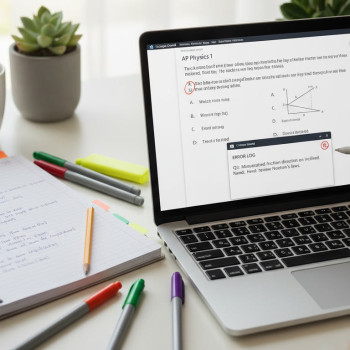Why Unit Conversion Matters (and Why It’s Not Just Busywork)
Picture this: you’re in the middle of an AP exam, a problem asks for the kinetic energy of a moving car, and your velocity is in kilometers per hour while the masses are in kilograms — but the formula expects meters per second. One small slip in conversion, and your perfect reasoning gets knocked off course. Unit conversion is the unsung hero of accurate problem solving. It keeps your numbers honest, your equations meaningful, and your answers defensible.

Core Concepts: SI Base Units and Why the Metric System Wins for Exams
The International System of Units (SI) is a global language for measurement. AP classes and exams favor SI because it’s consistent and easy to scale using prefixes. Here are the seven SI base units you should have at your fingertips:
- Length — meter (m)
- Mass — kilogram (kg)
- Time — second (s)
- Electric current — ampere (A)
- Temperature — kelvin (K)
- Amount of substance — mole (mol)
- Luminous intensity — candela (cd)
Why memorize them? Because complex units like newtons (N = kg·m/s2) and pascals (Pa = N/m2) are built from these basics. When you break composite units into base units, conversions become mechanical instead of mysterious.
Quick Tip: Always check what the formula expects
Before you plug in numbers, ask: are these inputs in the SI units the formula expects? Converting early prevents error propagation. For example, convert velocities to m/s and distances to meters before calculating energy or power.
Metric Prefixes: Tiny Words That Change Big Numbers
Metric prefixes are your scaling shortcuts. Each prefix represents a power of ten; knowing them allows you to move decimal places mentally instead of fumbling with arithmetic. Here are the most common prefixes tested on AP exams and used in lab reports:
| Prefix | Symbol | Value | Example |
|---|---|---|---|
| kilo | k | 103 | 1 km = 103 m |
| centi | c | 10-2 | 1 cm = 10-2 m |
| milli | m | 10-3 | 1 mm = 10-3 m |
| micro | µ | 10-6 | 1 µm = 10-6 m |
| nano | n | 10-9 | 1 nm = 10-9 m |
| mega | M | 106 | 1 MW = 106 W |
Memorize the common prefixes (kilo, mega, milli, micro, nano, centi) and get comfortable moving between them. Often, exam problems trick you with mismatched scales—spotting the prefix quickly avoids messy work.
Practice Exercise
Convert these mentally: 5.0 km to meters, 2500 mg to grams, 3.2 µs to seconds. Work them without a calculator and check that your shifts of decimal places match the prefix powers.
Orders of Magnitude and Scientific Notation: Thinking in Powers of Ten
Orders of magnitude help you estimate and sanity-check answers. Scientific notation condenses very large or very small numbers into a manageable form — ideal for the AP setting where speed and accuracy matter.
- Scientific notation: write numbers as a × 10n, where 1 ≤ a < 10.
- Order of magnitude: the exponent n gives the rough scale (e.g., 103 ≈ 102 is a factor of 10 apart).
Example: 0.00032 m = 3.2 × 10-4 m. Its order of magnitude is 10-4. When comparing 3.2 × 10-4 to 1.0 × 10-3, you can immediately tell they’re within a factor of about 3, and one is one order of magnitude smaller.
Why this helps on AP problems
AP exam questions sometimes require estimation. If an answer choice is off by several orders of magnitude, you can eliminate it fast. Estimation also helps you check whether your detailed solution is plausible before finalizing an answer.
Dimensional Analysis: The Detective Tool for Units
Dimensional analysis is the practice of treating units like algebraic quantities. If your units cancel to the desired unit, your equation is likely correct. This technique is indispensable for AP Physics and AP Chemistry.
Step-by-step approach
- Write down the desired unit first.
- Express each quantity with units attached.
- Cancel units algebraically until you reach the desired unit.
- If units don’t cancel correctly, you’ve found a mistake in your setup.
Example: Convert 90 km/h to m/s.
- Start with 90 km/h.
- Convert km to m: 90 × (1000 m / 1 km) = 90,000 m/h.
- Convert hours to seconds: 90,000 × (1 h / 3600 s) = 25 m/s.
- So 90 km/h = 25 m/s (approx.).
Common Conversion Pitfalls and How to Avoid Them
Even experienced students trip up on a few recurring pitfalls. Here’s how to outsmart them:
- Forgetting squared or cubed conversions: When converting units for area or volume, remember to square or cube the conversion factor (1 cm2 = 10-4 m2, 1 cm3 = 10-6 m3).
- Neglecting compound units: Watch units like J/(kg·K) carefully — break them into base units to check consistency.
- Miscalculating prefix shifts: Practice moving decimal points mentally; if unsure, do a quick scientific-notation check.
- Dropping units prematurely: Keep units visible until the final answer; they guide each algebraic step and prevent sign or factor mistakes.
Table: Handy Conversion Reminders
| Conversion | Factor | Use Case |
|---|---|---|
| km to m | × 103 | Speeds, distances |
| cm to m | × 10-2 | Small lengths, lab scales |
| mg to g | × 10-3 | Chemistry masses |
| µs to s | × 10-6 | Fast reaction times, electronics |
| Pa to N/m² | 1 | Pressure problems |
Real-World Examples to Train Your Intuition
Here are a few AP-style scenarios and how to navigate them efficiently.
1) Physics: Work and Energy
Task: A mass of 2.5 kg is lifted 3.0 m. Calculate the gravitational potential energy change using g = 9.8 m/s2.
Strategy: All quantities are already in SI. U = mgh = 2.5 kg × 9.8 m/s2 × 3.0 m = 73.5 J. Always check units: kg·(m/s2)·m = kg·m2/s2 = J.
2) Chemistry: Molar Volume
Task: Convert 2.5 L to cm3 for a lab calculation.
Strategy: 1 L = 1000 cm3? No — 1 L = 1000 cm3 is incorrect. The correct relation: 1 L = 1000 cm3 is actually true because 1 L = 1 dm3 and 1 dm = 10 cm, so 1 dm3 = 103 cm3. So 2.5 L = 2500 cm3. Understanding cube relations is key here.
3) Environmental Science: Concentration Units
Task: Convert 3.0 mg/L to µg/mL. Both are common on AP-style environmental or lab questions.
Strategy: 3.0 mg/L = 3000 µg / 1000 mL = 3.0 µg/mL. Tracking mass and volume units separately keeps the conversion smooth.
Study Strategies: Build Speed and Accuracy
Conversion skill grows through targeted practice, reflection, and the right habits. Try these strategies over a 2–4 week prep block before an exam:
- Daily micro-drills: Spend 10–15 minutes each day converting a short list of units. Rotating through physics, chemistry, and general measurements keeps the skill transferable.
- Flashcard prefixes: Make a set for metric prefixes and test yourself until you can move decimal points without thinking.
- Write units every step: Make it a non-negotiable habit to write the units at every step in a calculation.
- Estimate first: Before calculating exactly, estimate the order of magnitude to detect gross errors quickly.
- Mix contexts: Alternate chemistry moles with physics energies and biology concentrations so you don’t overfit to one subject’s patterns.
For many students, guided practice with a tutor makes the difference between understanding and mastery. Sparkl’s personalized tutoring can help here: 1-on-1 guidance, tailored study plans, and expert tutors can pinpoint weak spots in conversion habits. When a tutor shows you the precise mental steps and gives instant feedback, your speed and confidence improve faster than solo study.
Timed-Test Tactics: Converting Under Pressure
On the AP exam, time is often your toughest opponent. Use quick heuristics:
- If the answer choices are orders of magnitude apart, estimate the order first and eliminate wrong-tier choices.
- When stuck, convert to SI early. That standardizes everything and reduces decision fatigue later.
- Use scientific notation for extreme values — it’s faster for multiplying or dividing by powers of ten in your head.
- Keep a small cheat-sheet of common conversions in your head: km↔m, cm↔m, mg↔g, µs↔s, L↔m3, cm3↔L.
Practice Sets: Build from Basic to Complex
Work through layered challenges. Start simple (prefix exercises), then add scientific notation and dimensional analysis, then tackle compound problems that mix physics and chemistry concepts.
Sample progression (week by week)
- Week 1: Metric prefixes and decimal shifts. 20 problems/day.
- Week 2: Scientific notation and orders of magnitude. 15 estimation problems/day.
- Week 3: Dimensional analysis across physics and chemistry. 10 compound problems/day.
- Week 4: Full mixed timed sets simulating AP conditions. 2–3 practice exams or timed sections.
Pair this with targeted feedback. Personalized tutoring accelerates this loop — a tutor can correct small misconceptions immediately and provide custom practice that targets your weakest conversion pathways.

Final Checklist: Before You Submit an Answer
Run through this mental checklist to avoid preventable errors:
- Are all quantities in compatible units?
- Did you convert area/volume units with squared/cubed factors?
- Are your significant figures reasonable for the data given?
- Do the units of your final result match the requested units?
- Is the numerical magnitude plausible (quick order-of-magnitude check)?
Wrap-Up: Make Unit Conversion a Comfort Zone, Not a Chore
Unit conversion is a foundational skill for success on AP exams and in real scientific thinking. It’s less about memorizing a random set of facts and more about developing habits: keep units visible, favor SI, practice prefixes until they’re instinctive, and use dimensional analysis as your safety net. Over time, these habits free cognitive bandwidth so you can focus on the conceptual reasoning the AP tests are truly after.
If you want structured support, consider blending independent practice with occasional targeted coaching. Sparkl’s personalized tutoring offers tailored study plans, expert tutors, and AI-driven insights that can identify recurring conversion mistakes and help you close those gaps quickly — without taking over your study routine. A few strategic sessions can remove persistent roadblocks and convert shaky confidence into consistent accuracy.
Parting Challenge
Convert the following without a calculator and explain your reasoning in words (not just steps): A spaceship travels at 2.5 × 104 m/s. Express this speed in km/h and give its order of magnitude. Work it out, then check with scientific notation. If you want, write your steps and compare them with a study partner or tutor — explaining helps cement the mental shifts.
Mastering unit conversion is like learning to read the language of science fluently. The more you practice, the more natural it becomes — and when it’s second nature, you’ll find the AP exam a lot less intimidating and a lot more like the place to show what you truly understand.
















No Comments
Leave a comment Cancel